 |
|
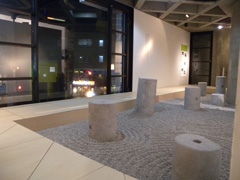 |
Hokutoshichisei, with its seven cylindrical stones representing the Big Dipper, is one of four gardens Mirei Shigemori created for Kyoto's Tofukuji temple in 1939. Formerly used in structural columns, the stones were recycled from the temple grounds -- an indication not only of Rinzai asceticism, but of Mirei's delight in the simple beauty of unadorned objects. Watari-um's installation reproduces their placement to scale.
|
Always a place for stimulating reflection on the design process, Tokyo's Watari Museum of Contemporary Art (Watari-um) has built a show around one of the most contemplative spaces Japan has to offer: the rock garden of Zen tradition. And it's no surprise that curator Etsuko Watari's focus falls on the controversial legacy of Mirei Shigemori (1896-1975), a designer and historian who brought to the karesansui style of dry landscape architecture such radical innovations as the use of geometric patterns and colored concrete.
Born in Okayama prefecture, Mirei was schooled from his teenage years in the fine arts of tea appreciation, ikebana, calligraphy, and brush painting; at university he studied Nihonga. He is well known for his contributions to the art of flower arrangement, both as critic and later as founding editor of Ikebana Geijutsu, a magazine dedicated to avant-garde flower design. Though his first experience with landscape architecture was creating a tearoom and garden on his family's property at the tender age of 18, his major professional debut came much later at age 42, after he had completed a three-year survey of Japan's gardens that took him to every prefecture in the land, covering some 400 sites.
Mirei published the results of this research in the 26-volume Illustrated Book on the History of the Japanese Garden and updated the study decades later in his seventies, producing the 35-volume Japanese Garden History Survey released after his death. Though as yet untranslated from the Japanese, these works remain, with their wealth of illustrations and plans, the definitive scholarly resource on the history and principles of traditional Japanese garden design.
 |
|
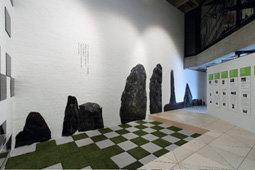 |
| The most adventurous of Mirei's Tofukuji designs, the northern garden juxtaposes square-cut stones and moss in a dynamic checkered pattern that's been playfully recreated at the museum. By purposefully contrasting the symbolic stone groupings (shown here on the gallery wall in life-sized cut-outs) of Tofukuji's southern garden, Mirei showcased his desire to express the simplicity of Zen precepts with abstract, contemporary elements. |
After spending his formative years caught up in the Modernism of the Taisho period (1912-26), then systematically codifying the traditions of the past through his research and writings, Mirei was perfectly primed for the role of the iconoclast. His conviction that the Japanese garden should be modernized is best seen in his 1939 masterpiece: the four gardens surrounding the abbot's hall of Kyoto's Tofukuji temple, two of which have been recreated at Watari-um.
Explaining her interest in Mirei, Watari says, "Of course his gardens are lovely to look at. But behind their design lie a rigorous philosophical approach and an activist spirit that would be fascinating to explore in any art form. I couldn't help but be drawn to that." A pet project of the Watari family that has been in incubation for more than ten years, the exhibition displays -- in addition to the scale reproductions and film presentations of Mirei's gardens -- paintings, calligraphy scrolls, and teahouse furnishings of his design, a number of which are shown in public for the first time. (So many were acquired on loan, in fact, that the exhibits will be changed monthly.) Mirei's relationship with sculptor Isamu Noguchi, with whom he toured Shikoku on a stone-gathering mission for the younger artist's UNESCO Gardens in Paris, is also introduced.
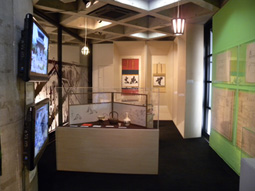 |
|
 |
| With exhibits of his site plans, writings, brushwork, and tea implements, the third-floor gallery offers an in-depth look at Mirei's design philosophy, which was rooted in the Zen approach to the "art of life." His relationship with sculptor Isamu Noguchi, whom he advised on the selection of stones for his work, is also highlighted. The pendant lighting fixtures, from teahouses, are of Mirei's design. |
Mirei created over 200 gardens in his lifetime, and approached their design as both a painting with the earth for its canvas and as a three-dimensional sculpture. To the orderly calm of the traditional contemplative garden, where rocks symbolize distant places in Buddhist mythology, he added a rapid movement of line and a compositional dynamism that reflect elements of Nihonga painting as well as the unorthodox style of ikebana he championed. Though his designs have been denounced for their unconventional themes and their use of such non-traditional materials as stone tiling and short-lived concrete, they nonetheless uphold the Zen tenet that values the process through which perfection is sought as much as perfection itself.
With its gallery gardens and virtual gardens, the Watari-um show makes a pleasant break from a busy day, whether visited on your lunch hour or in between meetings. Each afternoon from 4 p.m., a gallery representative gives a brief introduction to the exhibition (in Japanese), starting in the moss garden on the second floor. Tours to a number of Mirei's real-world gardens led by specialists in architecture and landscape design (also conducted in Japanese) are planned in January, February, and March -- some going as far afield as Shimane and Yamaguchi prefectures. Please see the museum website for details.
 |
|
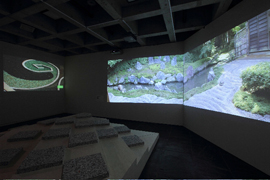 |
On the fourth floor, camerawork executed from just the right height takes visitors on a Hi-vision virtual stroll through several of Mirei's gardens; a raised dais invites you to sit back and take it all in. Separate presentations show bird's-eye views and introduce in the artist's own words his concepts and design aspirations for still other gardens.
|
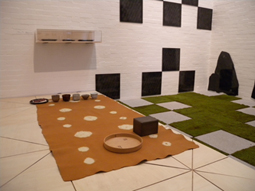 |
|
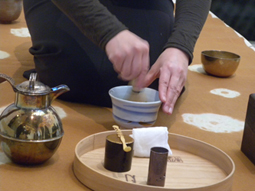 |
Each Saturday until the exhibition ends, Tsukiko Watari prepares servings of matcha tea in the recreated Tofukuji garden, sharing with participants some insights into Mirei's life and design ethic. (The exhibit remains open during this service, but reservations are required for participation in the ceremony, which is conducted in Japanese only.)
All images courtesy of, or by permission of, Watari-um |
|